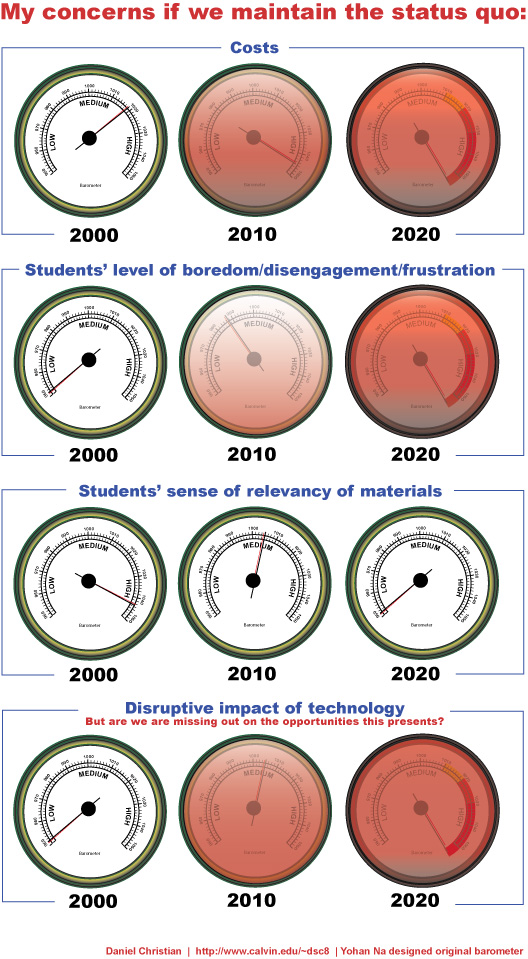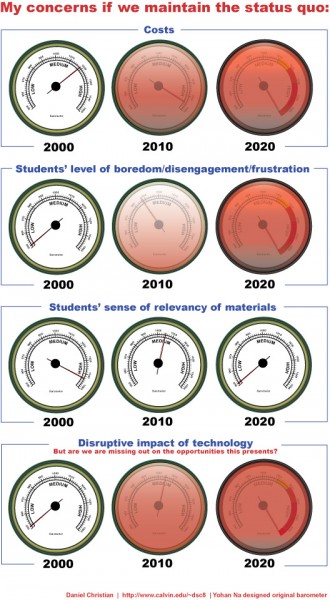From DSC:
This report reminds me of a graphic that Yohan Na and I did 10+ years ago…and the student debt now sits at around $1.5 trillion.

Get Smart About Going Online: Choosing the Right Model to Deliver Digital Programming — from evolllution.com by Charles Kilfoye
A veteran online educator looks at the benefits and pitfalls for each of the three main ways to launch an online program.
Excerpt:
Online learning is making headlines again with big players such as University of Massachusetts and California Community College Online launching high profile online initiatives recently. Some would argue that if you haven’t made it in online education already, you’ve missed your opportunity.
However, my sense is it’s never too late. You just have to be smart about it. It all boils down to asking yourself the basic problem-solving questions of Why, What and How to determine if online education is right for your institution. To illustrate my point, I will briefly discuss major considerations you should make when exploring an online strategy and I will examine the pros and cons of the three most common models of delivering online programs in higher education today.
…
Be aware that differentiated pricing may indicate to prospective students that one format is more valuable or better than another. My personal opinion is that a degree earned online should be considered the same degree as one earned on-ground. It is the same program, same faculty, same admissions requirements, same relevance and rigor, so why not the same cost?
From DSC:
Regarding the topic of pricing, it would be my hope that we could offer online-based programs at significantly discounted prices. This is why I think it will be the larger higher education providers that ultimately win out — or a brand new player in the field that uses a next gen learning platform along with a different business model (see below article) — as they can spread their development costs over a great number of students/courses/program offerings.
If the current players in higher ed don’t find a way to do this (and some players have already figured this out and are working on delivering it), powerful alternatives will develop — especially as the public’s perspective on the value of higher education continues to decline.

I’d also like to hear Charles’ thoughts about pricing after reading Brandon’s article below:
If it’s more expensive, it must be better. That, of course, has been the prevailing wisdom among parents and students when it comes to college. But that wisdom has now been exposed as an utter myth according to a new study published in The Journal of Consumer Affairs. It turns out the cost of a college does not predict higher alumni ratings about the quality of their education. In fact, the opposite is true: total cost of attendance predicts lower ratings.
…
Quality matters. Price does not. Quality and price are not the same things. And this all has enormous implications for the industry and its consumers.
Drones from CVS and Walgreens are finally here—and they’re bringing Band-Aids — from fastcompany.com by Ruth Reader
With UPS and Google sister company Wing as partners, the big pharmacies are starting to deliver pills, Cheez-Its, and first-aid supplies by drone.
From DSC:
Add those drones to the following amassing armies:
In case you missed it, WMU-Cooley’s President and Board of Directors took a look at our tuition rates and made the decision to reduce them by 21 percent starting Fall 2020! https://t.co/FjC6hk4vnE pic.twitter.com/NkCMAzoomE
— WMU-Cooley Law School (@WMUcooleylaw) October 16, 2019
From DSC:
Regular readers of this blog will know that for years, I’ve made it one of my goals to try and raise awareness of the need for institutions of higher education to lower their tuitions! For example, Yohan Na and I designed the graphic below way back in 2009.

Through those years, I cringed when I kept hearing various Boards say, “We only increased our tuition by ___ % — the lowest percentage increase in our state.” The direction was completely wrong! It needed to go down, not up. If you work in higher ed, I encourage you to find a way for that to happen at your own institution.
So I’m very pleased to report that the WMU-Thomas M. Cooley Law School — where I work — was able to reduce tuition by 21%!!!
Don’t get me wrong, some tough decisions were made to pave the way for that to occur. But this will be the case no matter which institution of higher education that you look at. An institution will have to make some tough choices to reduce their tuition. But it HAS to occur. We can’t keep this upward trajectory going.
If we don’t change this trajectory, we will continue to put enormous gorillas (of debt) on our graduates’ backs! Such debt will take our graduates decades to pay off.
We need to be aware of these invisible gorillas of debt. That is, our students move on…and we don’t see them. But their gorillas remain.
Addendum on 10/18/19:
Victoria Vuletich, the assistant dean at the Grand Rapids, Michigan campus of Western Michigan University Cooley Law School, was interviewed by the State Bar of Michigan’s Legal Talk Network to discuss what the law school experience is like for the current generation of students.
Priorities for new lawyers are changing. Can the legal industry keep up? — — from law.com by Annie Datesh, Natasha Allen, and Nicole Hatcher, Atrium
As the legal field continues to move forward, it is well-primed to place greater value on technological advancements, diverse leadership, and healthy work cultures over settling for the status quo.
Excerpts:
Yet the legal industry these lawyers are joining is evolving, and now increasingly hosts a new cohort of professionals—those shaped by technology and innovation, and who value diversity, mentorship, and efficiency over homogeneous workplaces with minimal coaching and exhausted capacities.
…
Amid a strengthening job market, why are jobs in a generally well-respected industry being looked over in favor of other industries? One reason could be the legal industry’s notorious lack of progressiveness. The industry’s technology landscape is one such area of slow growth; its lack of diversity is another.
The legal industry’s long-standing dismissal of technology, while slowly changing, is fairly well known. While legal technology holds enormous potential for law firms, the industry as a whole has been famously slow to adopt modern technologies or meaningfully innovate on the traditional law firm business model. Why? For smaller firms, money can be tight, and solutions can be expensive.
The good news is that the legal industry is slowly but surely becoming more receptive to the benefits of evolving its traditional approach to the business and practice of law. Legal technologies continue to offer increased efficiencies to law firms, should they elect to adopt them, and the call for diversity and other cultural improvements within firms and the legal industry more broadly is on the rise.
…
Those players in the legal industry who are able to recognize prevailing industry trends now will be in the best position to act on them.
An inserted graphic from DSC:

Walgreens to test drone delivery service with Alphabet’s Wing — from cnbc.com by Jasmine Wu
Key Points:
Add that to these other robots, drones, driverless pods, etc.:
From DSC:
Is a wild, wild west developing? It appears so. What does the average citizen do in these cases if they don’t want such drones constantly flying over their heads, neighborhoods, schools, etc.?
I wonder what the average age is of people working on these projects…?
Just because we can…